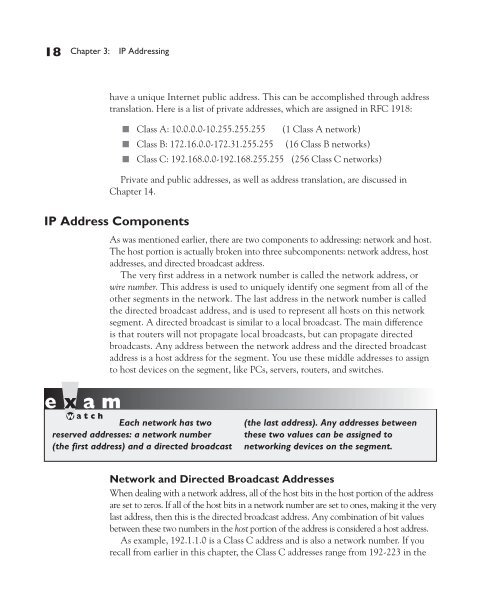ch03 IP Addressing.pdf - The Cisco Learning Network
ch03 IP Addressing.pdf - The Cisco Learning Network
ch03 IP Addressing.pdf - The Cisco Learning Network
You also want an ePaper? Increase the reach of your titles
YUMPU automatically turns print PDFs into web optimized ePapers that Google loves.
18 Chapter 3: <strong>IP</strong> <strong>Addressing</strong><br />
have a unique Internet public address. This can be accomplished through address<br />
translation. Here is a list of private addresses, which are assigned in RFC 1918:<br />
■ Class A: 10.0.0.0-10.255.255.255 (1 Class A network)<br />
■ Class B: 172.16.0.0-172.31.255.255 (16 Class B networks)<br />
■ Class C: 192.168.0.0-192.168.255.255 (256 Class C networks)<br />
Private and public addresses, as well as address translation, are discussed in<br />
Chapter 14.<br />
<strong>IP</strong> Address Components<br />
As was mentioned earlier, there are two components to addressing: network and host.<br />
<strong>The</strong> host portion is actually broken into three subcomponents: network address, host<br />
addresses, and directed broadcast address.<br />
<strong>The</strong> very first address in a network number is called the network address, or<br />
wire number. This address is used to uniquely identify one segment from all of the<br />
other segments in the network. <strong>The</strong> last address in the network number is called<br />
the directed broadcast address, and is used to represent all hosts on this network<br />
segment. A directed broadcast is similar to a local broadcast. <strong>The</strong> main difference<br />
is that routers will not propagate local broadcasts, but can propagate directed<br />
broadcasts. Any address between the network address and the directed broadcast<br />
address is a host address for the segment. You use these middle addresses to assign<br />
to host devices on the segment, like PCs, servers, routers, and switches.<br />
Each network has two<br />
reserved addresses: a network number<br />
(the first address) and a directed broadcast<br />
(the last address). Any addresses between<br />
these two values can be assigned to<br />
networking devices on the segment.<br />
<strong>Network</strong> and Directed Broadcast Addresses<br />
When dealing with a network address, all of the host bits in the host portion of the address<br />
are set to zeros. If all of the host bits in a network number are set to ones, making it the very<br />
last address, then this is the directed broadcast address. Any combination of bit values<br />
between these two numbers in the host portion of the address is considered a host address.<br />
As example, 192.1.1.0 is a Class C address and is also a network number. If you<br />
recall from earlier in this chapter, the Class C addresses range from 192-223 in the

















